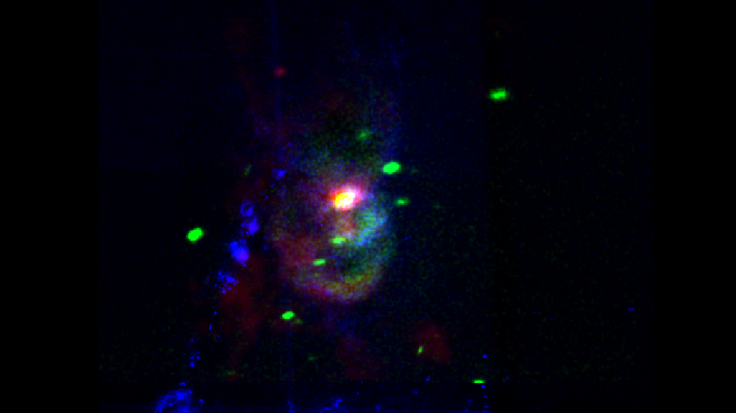Supermassive Black Hole At This Dwarf Galaxy’s Center Suffers From ‘Indigestion’

A dwarf galaxy about 26 million light-years away has been found with a supermassive black hole at its center that suffers from periodic “indigestion.” The phenomenon leads to the matter being blasted out into the interstellar medium from NGC 5195, which is in the process of merging with its larger neighbor NGC 5194, also called the Whirlpool Galaxy.
Earlier observations of NGC 5195 found this indigestion was possibly responsible for the creation of new stars within the galaxy. And while researchers speculated at the time that interactions between the galaxy and its neighbor could be the reason for the ejection of matter from the supermassive black hole, they were not sure of the exact nature of those interactions.
Read: Belching Supermassive Black Hole Seen Giving Life To New Stars In Galaxy NGC 5195
New observations of NGC 5195’s core, made using the e-MERLIN radio array in the United Kingdom, were combined with archival images of the surrounding area — collected by the Very Large Array (VLA) in New Mexico, Chandra X-ray Observatory and the Hubble Space Telescope — by a team of researchers, who explained details of the interaction between the galaxy pair.
Hayden Rampadarath from the Jodrell Bank Centre for Astrophysics at the University of Manchester in the United Kingdom presented a paper on the subject at the ongoing National Astronomy Meeting (NAM) 2017 in Hull, U.K. According to the researchers, matter streams onto the supermassive black hole at the center of NGC 5195 when the smaller galaxy falls into the outer arms of the Whirlpool, something that happens once every couple of hundred million years in the process of their merger.

As matter falls onto the supermassive black hole, it forms an accretion disk which eventually grows too large for the black hole to “digest” efficiently. This black hole has a mass of about 19 million suns, and therefore, once the accretion process breaks down, a very powerful shockwave is generated that blasts matter out into the interstellar medium. This forms the basis for the creation of new stars, as was observed earlier.
Read: Astronomers Verify Existence Of Orbiting Supermassive Black Holes
The shock wave also leads to heating of the interstellar medium and the creation of arcs of X-ray emissions that had been previously observed by Chandra.
“The age of the arcs in NGC 5195 is 1-2 million years. To put that into context, the first traces of matter were being forced out of the black hole in this system at about the time that our ancestors were learning to make fire. That we are able to observe this event now through such a range of astronomical facilities is quite remarkable,” Rampadarath said in a statement on NAM’s website.
Both NGC 5195 and the Whirlpool are located in the Messier 51 galaxy system, appearing in the constellation Canes Venatici. The merger of the two galaxies, caused by the gravitational pull of the larger of the two, will likely take billions of years to complete.
© Copyright IBTimes 2024. All rights reserved.











